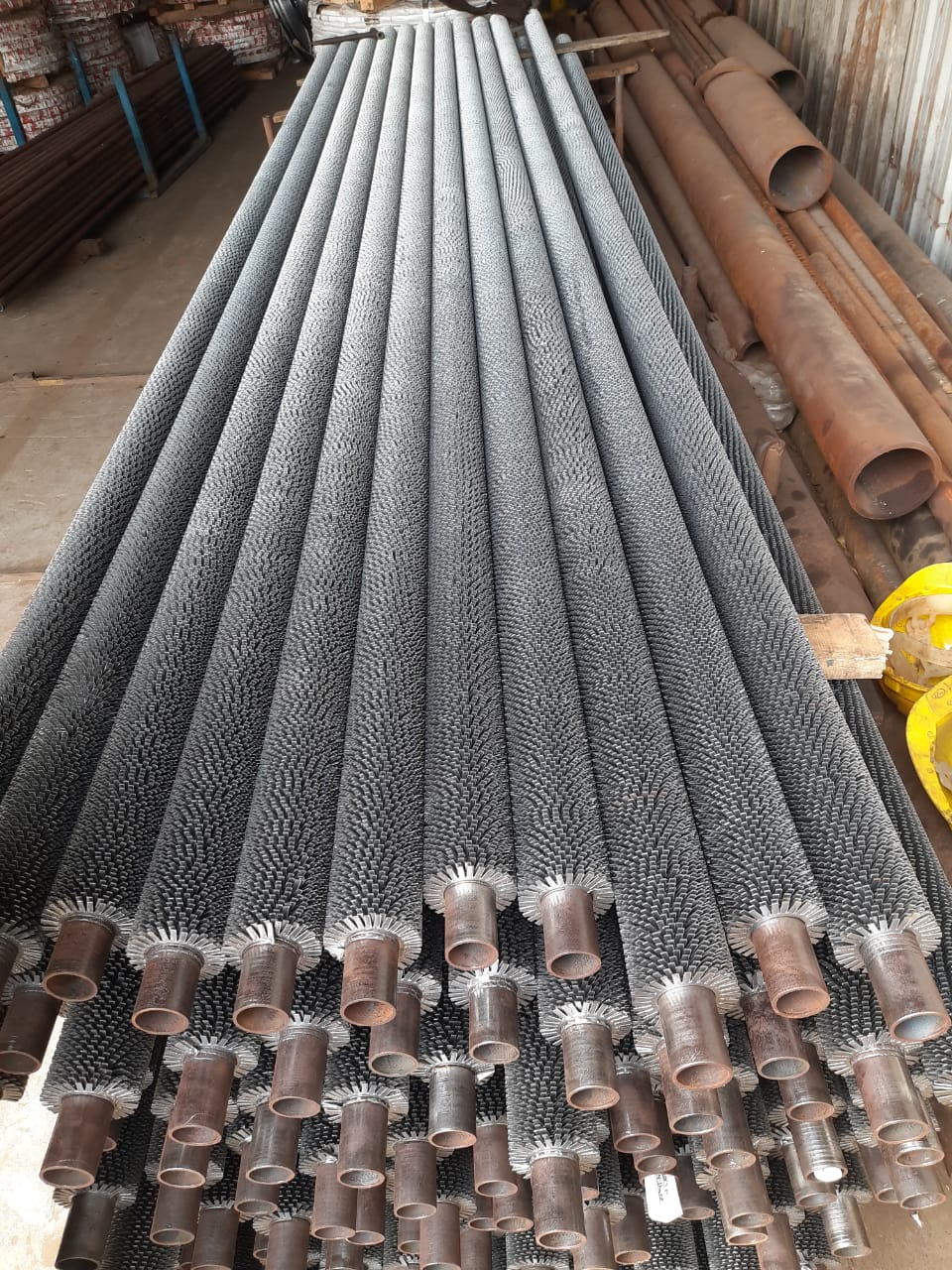Quick Inquiry
In the dynamic landscape of industrial operations, the quest for efficiency and sustainability reigns supreme. Amidst this pursuit, economizer tubes emerge as indispensable components, with the power to revolutionize boiler systems and redefine energy utilization.
As a leading manufacturer of economizer tubes, we have compiled this article to help you understand their construction and applications, and the advantages they offer to businesses and industries alike.

What is an Economizer Tube?
An economizer tube is a vital component in boiler systems designed to improve thermal efficiency by recovering heat from the flue gases. These tubes are typically installed in the boiler’s exhaust stack or between the boiler drum and the chimney. They facilitate the preheating of feedwater by utilising the residual heat energy from the exhaust gases before they are released into the atmosphere.
What is the Purpose of an Economizer Tube?
The primary purpose of an economizer tube is to recover heat from the flue gases generated during the combustion process. By capturing this waste heat, the tubes help preheat the boiler feedwater, thereby reducing the overall fuel consumption required to raise the feedwater temperature to the desired level. This process significantly improves the thermal efficiency of the boiler system, leading to substantial cost savings and environmental benefits.
Moreover, economizer tubes play a crucial role in mitigating thermal stress on boiler components by lowering the flue gas temperature before it enters the chimney. By reducing the temperature of the exhaust gases, they prevent corrosion and prolong the service life of the boiler system.
Construction and Working Principles of Boiler Economizer Tubes
Boiler economizer tubes are typically constructed from high-quality materials such as carbon steel, stainless steel, or alloy steel to withstand the harsh operating conditions encountered in industrial boilers. These tubes are often finned to increase the surface area available for heat exchange, enhancing their efficiency in capturing waste heat from the flue gases.
The working principle of boiler tubes revolves around heat transfer through conduction and convection. As the hot flue gases pass through the tubes, heat is transferred to the surrounding water or steam, raising its temperature and reducing the energy required to heat it further in the boiler system. The preheated feedwater is then supplied to the boiler drum, where it undergoes further heating before being converted into steam.
The efficiency of economizer tubes is influenced by various factors, including the design and layout of the tubes, the flow rate and temperature of the flue gases, and the properties of the heat transfer surfaces. Proper sizing, installation, and maintenance of the tubes are essential to ensure optimal performance and maximize energy savings.
The Function of Boiler Economizer Tubes
One of the primary functions of economizer tubes is to recover heat from the hot flue gases produced during the combustion process in boilers. These flue gases contain valuable thermal energy that would otherwise be wasted if not captured and utilized effectively. By passing the flue gases through the tubes, the heat energy is transferred to the surrounding water or steam, raising their temperature before they enter the boiler system.
The preheating of boiler feedwater is another essential function facilitated by economizer tubes. Preheating the feedwater before it enters the boiler drum significantly reduces the demand for additional fuel to raise the water temperature to the desired level. This not only lowers fuel consumption but also minimizes operating costs and environmental impact by decreasing greenhouse gas emissions associated with combustion.
The preheating of feedwater can enhance the overall efficiency and performance of the boiler, leading to improved productivity and reliability in industrial operations.
Waste Heat Recovery Concept of Boiler Economizer Tubes
The concept of waste heat recovery lies at the heart of boiler economizer tubes. In industrial processes, a significant amount of heat energy is generated and discharged as waste through flue gases. However, this waste heat contains latent energy that can be recovered and utilized to fulfill various heating requirements within the system.
Boiler tubes utilize the principle of heat exchange to recover waste heat from flue gases and transfer it to the boiler feedwater. This process involves the flow of hot flue gases over the surface of the tubes, which are typically finned to increase the heat transfer area. As the flue gases lose heat to the cooler surface of the tubes, the temperature of the gases decreases while the temperature of the water or steam inside the tubes increases.
The recovered heat energy is then used to preheat the boiler feedwater, thereby improving the overall thermal efficiency of the boiler system. By harnessing waste heat through economizer tubes, businesses, and industries can achieve significant energy savings, reduce reliance on fossil fuels, and mitigate environmental impact.
Advantages of Economizer Tubes
Economizer tubes stand as essential components in industrial boiler systems, offering a myriad of advantages that positively impact operational efficiency, cost-effectiveness, and environmental sustainability. Here are the key advantages of incorporating them into your industrial processes:
Enhanced Energy Efficiency:
They play an important role in enhancing energy efficiency within industrial boiler systems by recovering waste heat from flue gases. This recovered heat is utilised to preheat boiler feedwater, reducing the energy required for further heating in the boiler. By maximising the utilisation of heat energy that would otherwise be lost, economizer tubes significantly contribute to lowering overall energy consumption and operational costs for businesses.
Cost Savings:
The utilisation of the tubes translates directly into cost savings for industries operating boiler systems. By reducing the amount of fuel required to achieve the desired temperature of the boiler feedwater, businesses can realise significant reductions in fuel consumption and associated costs. Furthermore, the extended service life of boiler components resulting from decreased thermal stress further contributes to cost savings by reducing maintenance expenses and minimising the need for component replacements.
Environmental Sustainability:
Incorporating economizer tubes into industrial processes aligns with the goal of environmental sustainability by minimising greenhouse gas emissions. By optimising energy utilisation and reducing reliance on fossil fuels, the tubes help mitigate the environmental impact of industrial operations. This commitment to sustainability not only benefits the environment but also enhances the reputation of businesses as responsible corporate citizens.
Operational Reliability:
The tubes enhance the operational reliability of boiler systems by preheating boiler feedwater, thereby improving overall system performance. By reducing thermal stress on boiler components, they minimise the risk of breakdowns and unplanned downtime. This increased reliability ensures uninterrupted operation, enhances productivity and maintains a competitive edge for businesses in various industries.
Versatility in Applications:
They offer versatility in applications, as they can be customised to meet specific operational requirements and adapt to diverse industrial environments. With various configurations of finned tubes available, including extruded, welded, L-finned, G-finned, and H-finned tubes, businesses have the flexibility to choose the most suitable option for optimising heat transfer efficiency in their unique operating conditions. This adaptability ensures that economizer tubes can effectively meet the needs of a wide range of industrial applications, from power generation to chemical processing.
Types of Finned Tubes Used in Economizer Tubes
Finned tubes are integral components of economizer tubes, enhancing heat transfer efficiency and contributing to the overall performance of industrial boiler systems. Various finned tubes are utilised, each offering unique characteristics and advantages tailored to specific application requirements. Here are some of the common types:
Extruded Finned Tubes:
Extruded economizer finned tubes are formed by extruding fins from the parent tube material. This manufacturing process ensures a strong bond between the fins and the base tube, resulting in excellent heat transfer efficiency and mechanical stability. Extruded finned tubes are well-suited for high-temperature applications where reliability and durability are paramount.
Welded Finned Tubes:
Welded economizer finned tubes feature fins that are welded onto the outer surface of the base tube. This construction method offers flexibility in selecting different materials for the fins, making them suitable for corrosive environments or applications requiring specific material properties. Welded finned tubes provide robust performance and can withstand high-pressure conditions.
L-Finned Tubes:
Economizer L-finned tubes have fins arranged in a helical pattern along the length of the base tube, forming an ‘L’ shape. This design maximises surface area for heat transfer, enhancing efficiency while maintaining structural integrity. L-finned tubes are commonly used for their excellent heat transfer performance and resistance to fouling.
G-Finned Tubes:
Economizer G-finned tubes feature fins shaped into a ‘G’ configuration, providing increased turbulence and heat transfer efficiency. The unique design of G-finned tubes promotes optimal heat exchange, making them suitable for applications where maximum thermal performance is desired.
H-Finned Tubes:
Economizer H-finned tubes have fins arranged in a double-row pattern resembling the letter ‘H’. This configuration offers enhanced heat transfer surface area and improved efficiency in heat exchange. H-finned tubes are often utilised in economizer tubes for their superior performance in optimising energy utilisation and reducing fuel consumption.
Each type of finned tube offers distinct advantages in terms of heat transfer efficiency, mechanical strength, and compatibility with different operating conditions. By selecting the appropriate finned tube configuration, businesses can optimise the performance and reliability of their tubes, contributing to cost savings and operational excellence in industrial processes.
Read More: High Fin Tubes vs. Low Fin Tubes: Which One Is For You?
We Supply High-Quality Economizer Tubes for Small Scale and Large Scale Projects
Anand Seamless Ltd is a long-established manufacturer of seamless tubes and heat exchanger tubes. With decades of expertise in engineering tubes with precision and quality, you can experience the difference with our high-quality economizer tubes.
Each product is meticulously crafted to meet the demands of both small-scale and large-scale projects. Whether you’re embarking on a new venture or seeking to optimise existing operations, our economizer tubes are engineered to deliver unparalleled performance and reliability.
Elevate your industrial processes with our heat exchanger tubes that exceed expectations, backed by our unwavering commitment to quality and customer satisfaction. Get in touch with us to discover how our tubes can propel your projects to new heights of success. Contact us at +91-9099996853 or write to us at inquiry@anandseamless.com. If you are looking for export service, call us at biz@anandseamless.com. We will be happy to assist you.
lATEST BLOG |
|
How to Select the Right SA 179 Seamless Tube For Your Project?
Choosing the right SA 179 seamless tube for your p |
|
An Introductory Guide to Understanding Evaporator Tubes
Evaporator tubes are crucial components in various |
|
Guide to Maintaining Steam Coil Heater Tubes in HVAC Systems
Steam coil heater tubes are integral to the effici |
|
Carbon Steel Tubes: Essential Components in Shipbuilding
Selecting the right materials is of utmost importa |
|
How to Choose Right Grade Carbon Steel Seamless Tubes
Carbon steel seamless tubes are essential componen |

